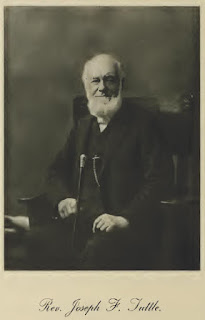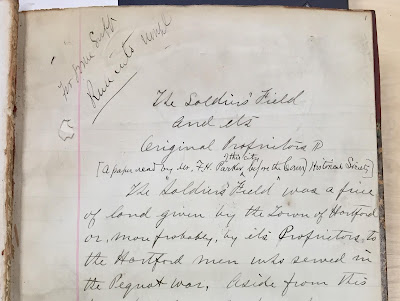I am the Registrar of the Milwaukee chapter of the Daughters of the American Revolution, and enjoy immensely the time I spend helping our prospective members climb their family trees.
Climbing all the way to the American
Revolution can be a daunting task. Sometimes there is a dead branch, and a new direction is needed. (Commonly called a "brick wall" but I am talking trees here.) Or a branch that seemed sturdy may unexpectedly
start to sway. After spending hours buried in musty old books, or
online in front of a computer screen, or at a copy machine with quarters in one hand and documents from a church, a courthouse,
or a library in the other, the illusive apple - a Revolutionary War patriot – may still seem out of reach.
What to do? Keep climbing. And during the climb, try not to be too busy to enjoy the low hanging fruit. Some of the apples hanging there may be the tastiest on the tree, so stop for a minute, and enjoy.
I have had fun picking apples off my family tree. And
not just the ones that hang high and far back in history. When I paid attention to the low hanging fruit, I got a taste of lots of things I never expected...
The Germans
I moved to Milwaukee in 1981. Until that time the only part of the city I had visited was the freeway, and the only people I knew were Laverne, Shirley, and The Fonz. Thirty years later I discovered that my 2x great-grandparents were early members of the Wisconsin Evangelical Lutheran Synod, and are buried in Milwaukee County! And if you go into the Zeidler Humanities Room at the downtown library, where I first found proof of an ancestor's patriot service to America, you can see the family farm on an old plat map hanging on the wall. Who would have known....
 |
J. Roth in Section 21
part of Oak Creek |
 |
German language headstone of
Karolina Roth, St. John's
Lutheran Church, Oak Creek WI |
The Swedes
When frightened and frightening Native Americans ran through "the Peterson farm" fields during the 1862 Dakota war, they were on land the federal government had sold to Swedish immigrant Hogan Peterson (Hakan Persson):
Hogan's son Peter (Per Hakansson) was then 18 and Peter's friend Anna Ring (I know her by no other name) was 16. They were both new to America, did they even speak English? They later married and are part of my family tree. I knew of them long ago, but have now also found the Peterson farm and stood in those fields.
 |
I am told they were strict but happy.
No one looked happy in these photos, the camera did not allow. |
I have seen their graves. Peter and Anna's parents were devout Baptists who fled Sweden to escape religious persecution by the state established Lutheran Church. They are buried in a small cemetery at the Grove City Baptist Church. I met the minister during my travels, who told me that years ago the church's safe was stolen. There was no money inside, but the original church records of my ancestors and their Swedish Baptist friends were in that safe, and those records are lost and gone forever. The marker on their family headstone remains, bearing Swedish script that translates as "For we know that if our earthly house of this tabernacle were dissolved, we have a building of God, a house not made with hands, eternal in the heavens." That is 2 Corinthians 5:1, but I never would have known without help (see caption below).
 |
The minister calls a friendly neighbor, who rushes over
to help us read 19th century Swedish |
Peter and Anna's son was a Baptist minister (I knew that), and in
1912 he traveled throughout North Dakota holding revival meetings (THAT was a big
surprise).
 |
| Young Baptist minister Alfred Peterson |
 |
| Saving souls in rural North Dakota |
He married a woman whose tree was full of New England bred apples, and went on to lead the American Baptist Church of Illinois. He died long before my parents' marriage. I knew that, but when I attended college in Fargo/Moorhead, I had no idea the young Swedish American minister had once traveled by train to Fargo and other North Dakota communities, encouraging audiences to "begin Christian life."
Yankees
A 2x great-grandfather named Charles Hause owned an 1,100 acre farm, and today part of that farm is part of Fort
Snelling National Park, near the Minneapolis/St. Paul airport. He bought the land in 1868, not long after the Native Americans had been moved west after the Dakota War (the same one witnessed by the Swedes). Hause was a successful farmer from upstate New York. He had an adventurous spirit, and had moved his family west after the death of his beloved first wife. The St. Paul papers took notice, saying "We are glad to see such men coming into our State, and Dakota county will welcome him-we know."
 |
| That's quite the Victorian farm house |
 |
| This land would be worth a fortune today! |
He had a daughter (my great grandmother) and a son. He sued his son and his second wife because of that land - I've read the court transcripts. Later that second wife sued
him for divorce claiming adultery - I've seen those transcripts as well. The land case went all the way to the Minnesota Supreme Court, where the son prevailed and some legal precedent was set. There is no record of how the divorce case got resolved. But the second wife was buried in Massachusetts with her parents when she died, the son was cut out of his father's will, and at the end of his life Charles Hause traveled the world, quite literally, and wrote travel articles published by his nephew in a paper in upstate New York, where Hause had grown up, and where he was eventually buried next to his first wife. Many years later his grand-daughter honored his memory by making the Hause family name my father's middle name. My father knew about the wealthy Yankee farmer and the land he owned. My father would have loved the rest of the story. As, I think, would his Baptist minister father -- they were quite the pranksters and loved good tales. My grandmother, maybe not so much, from what I hear, I'm guessing she knew the story and kept quiet....
The Norwegians
My mother’s
grandmother came to America from Norway, immigrating with
her brother in 1892, and landing in New York City after a 16 day trip on the ship SS Norge.
 |
| The ship that brought my great-grandmother to America |
She was born and raised on a remote fishing island far above the arctic circle, so the trip may not have been too much to bear. But once she arrived? I wonder which shocked her more: the Big Apple or the sod dugout she
lived in when she first came to the Midwest.
She met and married a Norwegian
machinist who helped electrify rural Minnesota. His father, by the way, had been a
professional fiddler back in Norway. Or should I say Sweden, since from 1814 to 1905 Norway was part of the "United Kingdoms of Norway and Sweden." Great grandpa was born in Norway, but came from "Sweden" and renounced allegiance to the kings of both Norway and Sweden when he became a US citizen.
He joined the Masons and considered himself American through and through, but when his daughter was confirmed years later, the confirmation record was in Norwegian.
The Depression
According to the Minneapolis City Directory, my 89 year old Yankee paternal great grandfather (the Baptist minister's father in law) was a "broker" in 1929. Photos and other family records reveal that my mother’s father Ed Roth was a young banker at the time, living with his growing family on the plains of North Dakota. Neither profession proved lucrative...
 |
Young Edwin Roth, farmer and banker in southwestern
North Dakota, on the eve of the drought, and the
locusts, and the dust, when everything went wrong |
Today I realize that my grandfather Roth’s
experiences during the Great Depression, coupled with his temperament
(and lack of temperance - he who drank too much) and probably the temperament of my delightful grandmother (the only grandparent I ever met, she of the Norwegian confirmation service, who later became a flapper), well, it all may explain why I grew up in suburban Minneapolis not knowing I had German
ancestors named Roth who by 1860 had become pioneers in Milwaukee County. I did not discover the Roths of Milwaukee until years after my mother had died (she who could not forgive), but I took her sister, and mine, to see their graves (we who were fortunate to come full circle).
Enjoy the Low Hanging Fruit and Honor Every Apple
These are but a few of the stories from the apples that hang low on my tree. Each ripe apple – a valued dead relative – holds a
delicious story, and I am enjoying every last bite. And every story eventually connects on my tree. Funny how that works.
Let me assure you, my
family is no more interesting than yours. The fruit hanging on each of our trees is
worth discovering, whether it hangs in the recent past or far up the tree to the time of the American Revolution or beyond. It is harvest time – go out and look for
apples, and when you find them, savor them. And don't forget that some of the fruit
hanging from our trees is not yet ripe. The dead people aren't going anywhere. Best to interview your LIVING relatives before it’s too
late!
A closing thought. You
will see above that one headstone is in German and one in Swedish. A confirmation record
is in Norwegian. My husband’s passport reveals he was born in
India. I am no prouder to descend from a man who landed on the coast of
Massachusetts in 1624 (and whose son made me a Colonial Dame), than I am to be married to an immigrant whose family moved to American to better their sons' education. We are, after
all, a land of immigrants, and should honor them all.
 |
In 1624 an English immigrant arrived at
Cape Ann, MA. He was put in charge of land operations but the entire
enterprise failed by the following year, and they all moved to a town they
named Salem. In 1907 the good folks of Cape Ann honored the failed
businessmen anyway, with a REALLY big marker -- it's behind the flag.
Here's what it looked like when the flag was taken down
(no, I haven't been there yet, the whole display seems quite incredible).
|









































